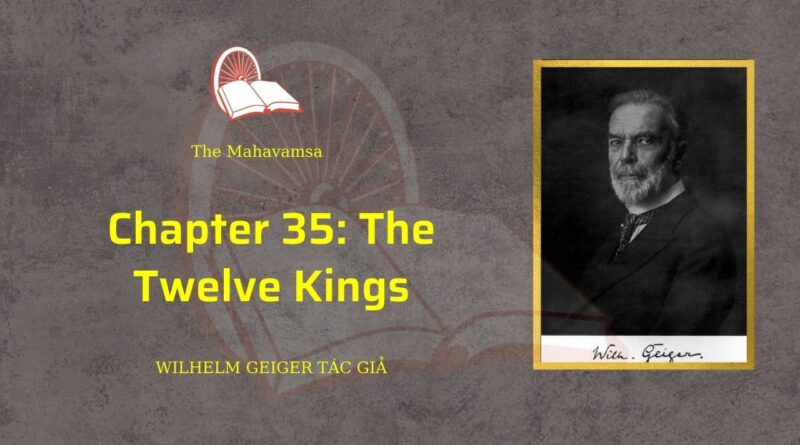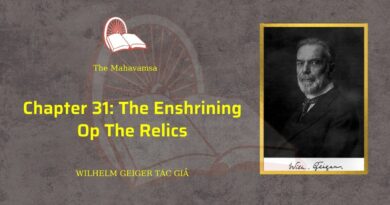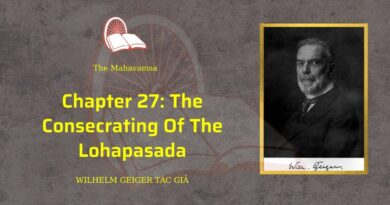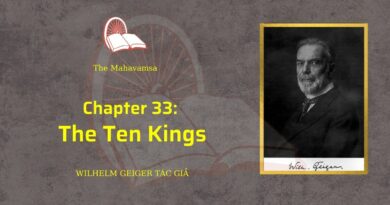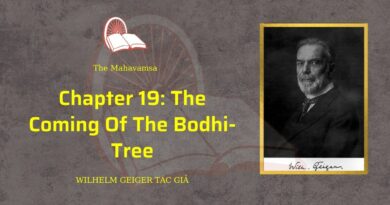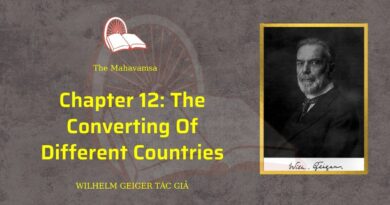THE MAHAVAMSA – CHAPTER 35: THE TWELVE KINGS
AFTER MAHA DATHIKA’s death AMANDA GAMANI, his son, reigned nine years and eight months. On the splendid Great Thupa he caused to be made a parasol above the parasol, and he built even there a vedi at the base and at the top. And in like manner he made an inner courtyard and an inner verandah to the Lohapasada and to the (building) called the Uposatha (house) of the Thuparama. Moreover, for both he built a beautiful pavilion adorned with precious stones; and the ruler of men also built the Rajatalena-vihara. When he had made the Mahagamendi-tank on the south side (of Anurädhapura), he, who was clever in works of merit, bestowed it on the Dakkhina-vihära. On the whole island the ruler of men commanded not to kill. All kinds of vine-fruits did he plant in divers places, and the king Amandiya, filling the almsbowis with the fruit called ‘flesh-melons’, and bestowing garments as a support (for the bowls) he gave of these, with believing heart, to the whole brotherhood; because he had filled the almsbowls (with them) be received the name AMANDA GAMANI.
His younger brother, the prince KANIRAJANU TISSA, reigned three years in the city, when he had slain his brother. He decided the lawsuit concerning the uposatha-house in the (vihara) named after the cetiya, but sixty bhikkhus who were invoived in the crime of high treason did the king order to be taken captive, with all that was theirs, upon the Cetiyapabbata, and he commanded these evildoers to be flung into the caves called Kanira.
After KANIRAJANU’s death AMANDA GAMANI’s son, the prince CULABHAYA, reigned a year. The king built the Culagallakavihara on the bank of the Gonaka-river to the south of the capital.
After the death of CULABHAYA his younger sister SIVALI, the daughter of AMANDA, reigned four months. But AMANDA’s nephew named ILANAGA dethroned Sivali and raised the parasol (of sovereignty) in the capital. When, one day, in the first year (of his reign), the king went to the Tissa-tank, many of the Lambakannas deserted him and went back to the capital. When the king saw them not he was wroth and (in punishment) he ordered that they, even they themselves, should make a road to the Mahäthüpa, commanding to stamp it down firmly, where it ran beside the tank, and he set caudalas to be their overseers. And full of anger because of this the Lambakannas came together, and when they had taken the king captive and imprisoned him in his palace they themselves administered the government; but the king’s consort put festal garments on her little son the prince Candamukhasiva, gave him into the hands of the serving-women and sent him to the state-elephant, charging (the attendants) with a message.
The serving-women conveyed him thither and gave the state elephant the queen’s whole message: ‘This is thy lord’s son; thy lord is in prison; better is it for this (boy) to meet his death by thee than by the enemies; then slay thou him: that is the queen’s command.’ With these words they laid him down at the elephant’s feet. And for grief the elephant began to shed tears, and breaking to pieces the posts (to which he was chained) he pressed forward into the palace and dashed against the gate with fury, and when he had broken down the door’ in the room where the king sat, he made him mount upon his back and went towards Mahatittha. There the elephant made the king embark on a ship (that brought him) to the western shore of the sea; he himself went toward Malaya.
When the king had stayed three years on the other coast he raised an army and went by ship to Rohana. Having landed at the haven Sakkharasobbha the king assembled there in Rohana a mighty force. Then came the king’s state-elephant forthwith out of the southern Malaya to Rohana to do him service. As he had heard there the Kapi-jataka from the great thera, the preacher of jatakas, named Mahäpaduma, who dwelt in the (vihara) called Tuladhara, he, being won to faith in the Bodhisatta, restored the Nagamahavihara and gave it the extension of a hundred unbent bows in length, and he enlarged the thüpa even to what it has been (since then); moreover, he made the Tissa-tank and the tank called Dura.
When the king had raised an army he marched to battle; when the Lambakannas heard this they also prepared themselves for battle. Near the gate of Kapallakkhanda on the field of Hankarapitthi was waged the battle between the two (armies) that brought destruction to both.
Since their bodies were exhausted by the sea-journey, the king’s men yielded their ground, therefore the king proclaimed his name and pressed forward. Terrified thereat the Lambakannas threw themselves down upon their belly, and they hewed off their heads and heaped them up high as the nave of the (king’s) waggon-wheel, and when this had come to pass three times the king, from pity, said: ‘Slay them not, but take them captive living.’
When then the king had come into the capital as victor in battle and had raised the parasol (of sovereignty) he went to a festival at the Tissa-tank.’ And when he, fully arrayed in his ornaments and armour, had withdrawn from the watersports and reflected on the good-fortune that he had attained, and thought of the Lambakannas who had opposed his progress, he was wroth and commanded that they be yoked two and two behind one another to his car, and thus did he enter the city in front of them. Halting on the threshold of the palace the king gave the command: ‘Here on this threshold, soldiers, strike off their heads.’ ‘These are but oxen yoked to thy chariot, O lord of chariots; therefore let their horns and hoofs be struck off,’ thus admonished by his mother the king recalled (the order) to behead them and commanded that their nose and toes be cut off. The district where the elephant had stayed the prince allotted to the elephant; and therefore the tract is called Hatthibhoga.
So ILANAGA, ruler of the earth, reigned full six years as king in Anuradhapura.
After the death of ILANAGA his son CANDAMUKHA SIVA reigned eight years and seven months as king.
When the lord of the earth had constructed a tank near Manikaragamaka he gave it to the vihara called Issarasamana. This king’s consort who was known by the name Damilidevi, allotted her own revenues from that village to the same vihara.
Having slain Candamukha Siva in the festival-sports at the Tissa-tank his younger brother, known by the name YASALALAKATISSA, reigned as king in delightful Anuradhapura, the fair face of Lanka, seven years and eight months.
Now a son of Datta the gate-watchman, named SUBHA, who was himself a gate-watchman, bore a close likeness to the king. And this palace-guard SUBHA did the king Yasalalaka, in jest, bedeck with the royal ornaments and place upon the throne and binding the guard’s turban about his own head, and taking himself his place, staff in band, at the gate, he made merry over the ministers as they paid homage to (SUBHA) sitting on the throne. Thus was he wont to do, from time to time.
Now one day the guard cried out to the king, who was laughing: ‘Why does this guard laugh in my presence?’ And SUBHA the guard ordered to slay the king, and he himself reigned here six years under the name SUBHARAJA.
In both the great viharas SUBHARAJA built a noble row of cells called SUBHARAJA after him. Near Uruvela (he built) the Valli-vihara, to the east the (vihara) Ekadvara and at the mouth of the Ganga the (vihara) Nandigamaka.
One sprung of the Lambakanna (clan), named VASABHA, whose home was in the northern province, served under his uncle, a commander of troops. Since it was declared: ‘One named Vasabha shall be king,’ the king at that time commanded that all in the island who bore the name of Vasabha should be slain. The commander, thinking: ‘We must deliver up our Vasabha to the king,’ and having taken counsel with his wife (upon the matter) set out early in the morning to go to the king’s residence. And the wife, to guard Vasabha carefully who went with him, put betel into his hand but without powdered chalk.
Now when the commander, at the gate of the palace, saw the betel without chalk, he sent him back for chalk. When Vasabha came for the chalk the commander’s wife spoke with him secretly, gave him a thousand (pieces of money) and aided him to take flight. Vasabha went to the Mahavihara and by the theras there was provided with milk, food and clothes, and when he had again heard from a leper the certain prophecy that be would be king, rejoicing he resolved: ‘I will be a rebel’ And when he had found men suited (to his purpose) he went, seizing in his further course village by village, according to the instruction (in the story) of the cake,’ to Rohana, and gradually winning the kingdom to himself he advanced, after two years, with theneedful army and train, towards the capital. When the mighty VASABHA had conquered SUBHARAJA in battle he raised the parasol (of sovereignty) in the capital. His uncle had fallen in battle. But his uncle’s wife, named Pottha, who had first helped him, did king VASABHA raise to be queen.
Once he questioned a soothsayer concerning the length of his life, and he told him secretly (that he should live) just twelve years. And when be had given him a thousand (pieces of money) to keep the secret the king assembled the brotherhood and greeted them reverently and asked them:
‘Is there perchance, venerable sirs. means to lengthen life?’ ‘There is,’ so did the brotherhood teach him, ‘a way to do away with the hindrances (to long life); gifts of strainers must be given and gifts of dwellings and gifts for maintenance of the sick, O ruler of men, and in like manner the restoring of ruined buildings must be carried out; one should take the five precepts on himself and keep them carefully, and one should also keep the solemn fast on the uposathaday.’ The king said: ‘It is well,’ and went thence and carried out all these (duties).
Every three years that went by the king bestowed the three garments on the whole brotherhood in the island; and to those theras that lived far away he sent them. In thirty two places lie ordered milk-rice with honey to be distributed, but in sixty-four places a lavish gift of mixed alms.
He had a thousand lamps lighted in four places; that is, on the Cetiya-pabbata, about the cetiya in the Thuparama, about the Great Thüpa and in the temple of the great Bodhi-tree.
In the Cittalakuta (vihara) he built ten beautiful thnpas and over the whole island he restored ruined buildings. From pious trust in a thera in the Valliyera-vihara he built the vihara called Mahavalligotta. And (moreover) he built the Anurarama (vihara) near Mahagama and bestowed on it a thousand and eight karisa (of land) of (the village) Heligama. When he had built the Mucela-vihara in Tissavaddhamanaka he allotted to the vihara a share in the water of the (canal) Alisara. To the thüpa in Galambatittha he added a mantling of bricks, and he built an uposatha-house too, and to provide oil for the lamps. he constructed a pond (yielding water to) a thousand karisa (of land)5 and gave it to the (vihara). In the Kumbhigallaka-vihara he built an uposatha-house. In like manner the king built an uposatha-house in the Issarasamanaka (vihara) here aud in the Thuparama a thüpa-temple. In the Mahavihara he built a row of cells facing the west, and he restored the ruined Catussala (hail). In like manner the same king made four beautiful Buddha-images and a temple for the images in the fair courtyard of the great Bodhi-tree.
The king’s consort, named Pottha, built in that same place a splendid thüpa and a beautiful temple for the thüpa. When the king had completed the thiipa-temple in the Thuparama he commanded lavish almsgiving for the festival of its completion. Among those bhikkhus who were busied with (the learning of) the word of the Buddha he distributed the things. needed (by bhikkhus), and among the bhikkhus who explained the doctrine butter and sugar-molasses. At the four gates of the city he had food given away to the poor and, to such bhikkhus who were sick, food suited to the sick. The Cayanti and the Rajappala-tank, the Vaba and the Kolambagamaka, the Mahanikkhavatii-tank and the Maharametti, the Kohãla and the Kali-tank, the Cambuti, the Citthamangaijia and the Aggivaddhamanaka: these twelve tanks and twelve canals he constructed, to make (the land) fruitful. For safety he built up the city wall even so high (as it now is) and he built fortress -towers at the four gates and a palace besides; in the garden he made a tank and put geese therein.
When the king had constructed many bathing-tanks here and there in the capital he brought water to them by subterranean canals. And in this way carrying out various works of merit king VASABHA did away with the hindrances (to long life), and delighting perpetually in well doing he reigned forty-four years in the capital. He appointed also fortyfour Vesakha-festivals.
Subharüja while he yet lived had anxiously, for fear of VASABHA, entrusted his daughter to a brick-worker and had at the same time given into his care his mantle and the royal insignia. When he was killed by VASABHA the brick-worker took her with him, put her in the place of a daughter, and brought her up in his own house. When he was at work the girl used to bring him his food.
When (one day) in a thicket of flowering kadambas, she saw an (ascetic) who was in the seventh day of the state of nirodha,’ she the wise (maiden) gave him the food. When she had then prepared food afresh she carried the food to her father, and when she was asked the cause of the delay she told her father this matter. And full of joy he bade (her) offer food repeatedly to the thera. When the thera had come out (of his trance) he said to the maiden, looking into the future: ‘When royal rank has fallen to thy lot then bethink thee, O maiden, of this place.’ And forthwith the thera died.
Now did king VASABHA when his son Vañkanäsikatissa had come to (full) age seek a fitting wife for him. When those people who understood the (auspicious) signs in women saw the maiden in the brick-worker’s village they told the king; the king thereon was about to send for her. And now the brick-worker told him that she was a king’s daughter, but that she was the daughter of SUBHARAJA he showed by the mantle and so forth. Rejoiced the king gave her (in marriage) to his son when all had been duly provided.
After VASABHA’s death his son VANKANASIKA TISSA reigned three years in Anuradhapura. On the bank of the Gonariver the king VankanAsikatissaka built the vihära called Mahamangala. But his consort Mahamatta collected money to build a vihãra, bethinking her of the thera’s words.
After VANKANASIKA TISSA ‘s death his son GAJABAHU I reigned twenty-two years. Hearkening to his mother’s word the king founded the Mätuvihära on the place of the thicket of flowering kadambas, in honour of his mother. His wise mother gave to the great vihära a hundred thousand (pieces of money) for the plot of land and built the vihara;’ he himself built a thüpa of stone there and gave (land) for the use of the brotherhood, when he had bought it from various owners.
He erected the great Abhayuttara-thupa, making it greater, and to the four gates thereof he made vestibules. When the king had made the Gamanitissa-tank he bestowed it on the Abhayagiri-vihara for maintenance in food. He made a mantling to the Maricavatti-thupa and gave (land) thereto for the use of the brotherhood, having bought it for a hundred thousand (pieces of money). In the last year he founded the vihara called Ramuka and built in the city the Mahejasanasala (hall).
After Gajabãhu’s death the king’s father-in-law MAHALLAKA NAGA reigned six years. (The viharas) Sejalaka in the east, Gotapabbata in the south, Dakapasana in the west, in Nagadipa Sälipabbata, in Bijagama Tanaveli, in the country of Rohana Tobbalanugapabbata, in the inland country Girihälika: these seven vihäras did the king MAHALLAKA NAGA, ruler of the earth, build in the time (of his reign), short though it was.
In this way do the wise, doing many works of merit, gain with worthless riches that which is precious, but fools in their blindness, for the sake of pleasures, do much evil.

